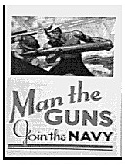Everett Richardson: There is nothing unique about my story of being a WWII veteran; it's just the way it affected me for the rest of my life.
 Julie Olson: Why did you decide to enlist in the Navy?
Julie Olson: Why did you decide to enlist in the Navy?
ER: I have always been near ships. My first job was captain's mess boy on a sea-going dredge, the USED Pacific, with the Corps of Engineering dredging harbor mouths here. When the war started, I was living at home here in North Bend, Ore.; it was and is a relatively small town. At the time the population was about 5,000 with another 9,000 living in the outlying areas. All the young folks were joining the service or being drafted, and there was money to be made in many industries.
My dad worked in a sulphite pulp mill here, and wages were better. They needed the product to make "gun cotton." During peacetime that type of wood pulp is used in making the finest magazines and writing paper. I don't think anyone considered whether we might lose the war, but of course we could have. That is very clear now!
In early 1942, I was 17 years old and a junior in high school when two friends and I decided to enlist. Not a lot of thought went into the decision. The point? To defeat the enemy!
Patriotism, I guess. Sounds a little hokey now, but we were moved by the attack on Pearl Harbor, though I'm not sure we even knew of the place before the event itself. We had to take the train to Portland, Ore., to enlist. We lied about our age because the law said we should be 18 years old. The Armed Forces needed men and looked the other way!
I chose the Navy because I had a cousin about 10 years older than me who was given a choice of joining the service or going to reform school. He made a career of it and, after the war, became a four-stripe Captain, Aviator. He was a PBY Flying Boat pilot during the war and was a member of the Black Cats flying group. PBY was the designation for a twin-engine flying boat built by Consolidated Aircraft in those days. It was a rather large, slow patrol craft used for things like observation of the enemy and submarine patrols, mostly early in the war. They were also good for air-sea rescues because they had a very strong hull and could land in medium-high seas.
Basic Training
It was November by the time we were called up. We were shipped to a new Naval Training Station in Idaho named U.S.N.T Station Farragut near Spokane, Wash. It was bitterly cold for guys from the temperate rain forest. We nearly all immediately came down with something called "cat fever" (catarrh). It laid us low! Nearly everyone ended up in the infirmary.
However, if you didn't need hospitalization, you marched, exercised, marched, exercised, and marched some more. All of that was done on "the Grinder," as it was called, but it was under about four inches of ice all the time I was there. Lake Pend Oreille was frozen over, and as a result we had no lifeboat drills. So we marched some more. We also studied the Blue Jackets Manual, a handbook that taught all the basic seamanship (knots, ropes, and many other things) that "boots" had to know to become apprentice seaman.
As new members of the naval organization, the name "boots" separated us from the enlisted men on base. The name originated with the canvas leggings we wore during every waking minute. Of course a boot was the lowest form of humanity, and we were reminded often of that - just to teach us a little humility, I expect. The drill instructor didn't let us forget our station in life very often, and our company officer was just one step below God! However, we could say just about anything we liked as long as they couldn't hear it.
They had large mess halls on the base at Farragut. The diet was pretty standard with a few additions that most of us had never heard of before. One in particular consisted of Navy beans baked with catsup until they were pretty thick in consistency. This meal was standard every Wednesday morning if we were at sea or shoreside. I personally liked Wednesday beans because we could have as much as we wanted; usually rations were a bit short on active duty! Another interesting dish was creamed, chipped beef (salted and dried) on toast, aptly named sh*t on a shingle. This meal could be served most any time.
More Everett Richardson: WWII Oral History
- WWII Veteran Richardson: Introduction
WWII Veteran Richardson: Join the Navy, Basic Training
WWII Veteran Richardson: Signal School, First Assignment
WWII Veteran Richardson: At Sea, At War
WWII Veteran Richardson: Discharged, Post-War Years
WWII Veteran Richardson: USS Kimberly DD-521 Statistics
WWII Veteran Richardson: USS Kimberly World War II Service
WWII Veteran Richardson: In Memory of Our Departed Shipmates DD 521
Back to Cry Havoc #30 Table of Contents
Back to Cry Havoc List of Issues
Back to MagWeb Master Magazine List
© Copyright 2000 by David W. Tschanz.
This article appears in MagWeb (Magazine Web) on the Internet World Wide Web. Other military history articles and gaming articles are available at http://www.magweb.com